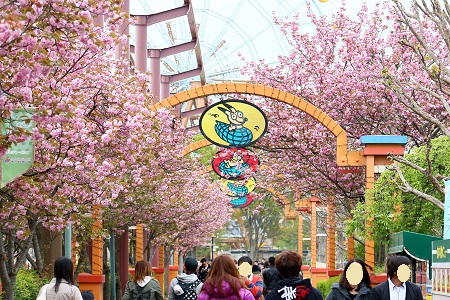I visited Tobu Zoo in Saitama prefecture to see biological impacts of Fukushima Daiichi nuclear power plant accident. Though I have visited various places in Japan to see the health consequence of the accident, I can find no effect against creatures in Japan.
Tobu Zoo is Saitama's largest leisure facilities, incorporating an amusement park and zoo. The amusement zone is located in the east of the vast site while the zoo zone is located in the west. Visitors can have a close look at a pair of white tigers, a rare species, in the zoo zone. The zoo zone provides a variety of attractions on a regular basis enabling visitors to pet and feed docile animals including ring-tailed lemurs, a rare species in Japan. The amusement zone offers a variety of attractions as well, and is equipped with many pleasant facilities ranging from high-speed equipment to a classic merry-go-round. The facilities include a go-cart circuit named Afri-Cart, where visitors can ride the go-carts and drive around live animals, and the world's first wooden water roller coaster named Regina.
So I visited Tobu zoo to see effects of the accident against animals which eat Japanese foods.
Fortunately, I could see them grown up safely and I couldn't find any impact of the accident. It seems that there is no problem for childbirth and child-rearing in Saitama, Japan.
Posted by Yoshitaka Kiriake from Japan on May 30, 2014.
東武動物公園は埼玉県最大のレジャーランドだ。子供から大人まで楽しめる遊園地で遊んだら、たくさんの動物たちがいる動物園で癒されよう。広大な敷地には四季折々の花々が咲き乱れ、バードウォッチングも出来る。カワウ、ハクセキレイ、コサギを撮影できた。2014年4月撮影
Hippopotamus
カバ
About Tobu Zoo
Google map
About Tobu railway
The amusement zone
From scary rides to heartwarming family attractions, there are more than 30 kinds of attractions for every visitor to enjoy all day.
The zoo zone
Approximately 150 species, a total of 1200 animals, including a rare species of white tigers live in the zoo.
Burmese python ( albino )
ビルマニシキヘビ
White tiger
ホワイトタイガー
Lion
ライオン
Common squirrel monkeys and Capybara
カピバラとリスザル
Wreathed Hornbill
シワコブサイチョウ
White Pelican
モモイロペリカン
We can see wild birds too.
Great Cormorant
カワウ
White Wagtail
ハクセキレイ
Little Egret
コサギ
Japanese foods are good and safe.
Because of stricter food safety law by Japanese government, we have no worry about foods.
Chahan : fried rice
Because of stricter food safety law by Japanese government, we have no worry about foods.
Chahan : fried rice
Kebab
Ramen
Cake
Pancake
About 3 years have passed since Fukushima Daiichi nuclear power plant accident. I have visited various places of Japan to see the health consequence of the accident.
Fortunately I have never found any impacts by the accident among Japanese creatures. As far as I know, nobody has health problem which is caused by the accident in Japan.
Our Prime Minister Abe assures that "The situation is under control. The influence of the contaminated water is completely blocked within Fukushima. There are no health-related problems until now and there will never be health problems." He also said that "Tokyo is 250 kilometers away from Fukushima, and the kind of danger that you imagine does not exist in Tokyo. Tokyo is a very safe city."
As PM Abe said, Saitama is very far away from Fukushima too, people in Saitama have no concern about the nuclear power plant accident. People in Saitama have already forgotten the accident, because they think radioactive materials cannot reach there.
We know there is no problem for child birth and child rearing in Saitama too. So people in Saitama are living without any concern about the accident. I continue to visit various places in Japan to see the effects of the accident, because I can meet various creatures which are more sensitive to radioactive materials from the environment. It is important to see their health for our safety.
公衆衛生ネットワーク
Public Health Network in Japan


































































